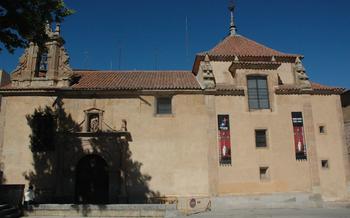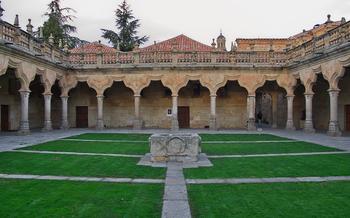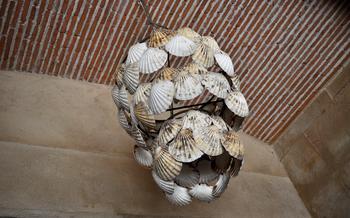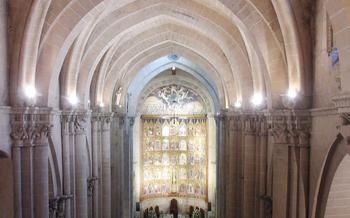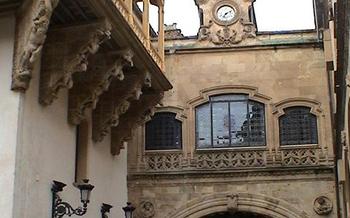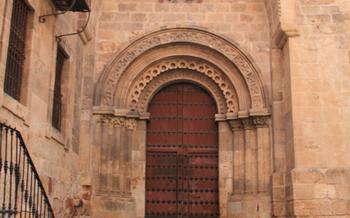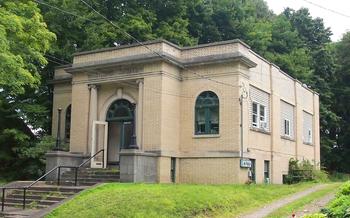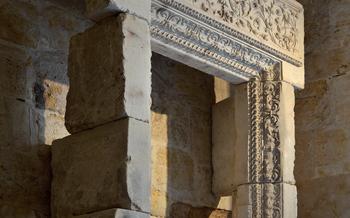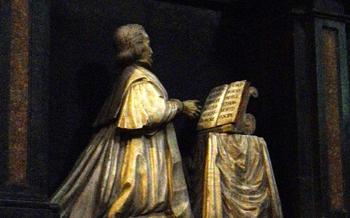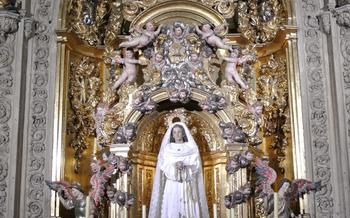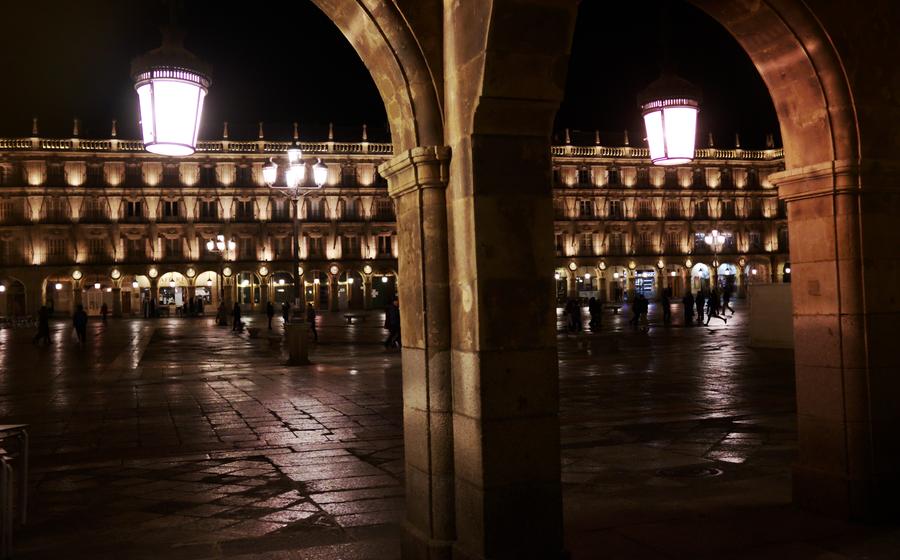
Chapel of la Vera Cruz
- Historical Significance:
- Architectural Marvel
- Artistic Treasures
- Pilgrimage and Devotion
- Guided Tours: Unveiling the Chapel's Secrets
- Self-Guided Exploration
- Photography and Videography
- Accessibility
- Hours of Operation and Admission Fees:
- Location and Transportation
- Nearby Attractions:
- Suggested Itineraries:
- Food and Drink Options:
- Accommodation Options:
- Insider Tip:
Historical Significance:
The Chapel of la Vera Cruz holds immense historical significance, dating back to its construction in the 12th century. Originally a Romanesque church, it was later transformed into a Gothic chapel in the 15th century, showcasing a harmonious blend of architectural styles. The chapel played a pivotal role as a meeting place for the Knights of the Order of the True Cross, a religious and military order dedicated to protecting and venerating the relic of the True Cross. Its strategic location near the city walls further emphasized its importance as a sacred site and a symbol of faith for the people of Salamanca. In the 20th century, the chapel underwent extensive restoration efforts, resulting in its designation as a national monument, ensuring its preservation for future generations to appreciate its historical and architectural grandeur.
Architectural Marvel
The Chapel of la Vera Cruz stands as a testament to the harmonious blend of Romanesque and Gothic architectural styles. Its exterior captivates with its imposing crenellated tower, a symbol of strength and resilience. Intricate carvings and sculptures adorn the facade, creating a visual symphony that transports visitors back in time. Step inside, and you'll be greeted by a breathtaking spectacle of ribbed vaults soaring overhead, supported by slender columns adorned with elaborate capitals. The pointed arches, a hallmark of Gothic architecture, create an ethereal and uplifting atmosphere. Throughout the chapel, symbolism and iconography abound, inviting visitors to decipher the stories and meanings hidden within the stonework. Every nook and cranny of this architectural masterpiece reveals the artistry and devotion that went into its creation.
Artistic Treasures
The Chapel of la Vera Cruz is home to a remarkable collection of medieval frescoes and paintings that adorn its walls and ceilings. These artworks, dating back to the 13th and 14th centuries, are not just decorative elements but profound expressions of religious devotion and artistic mastery.
The vibrant colors and intricate details of the murals captivate visitors, transporting them back to a time when faith and artistry intertwined. Biblical scenes, such as the Annunciation, the Nativity, and the Crucifixion, are depicted with a realism that brings the stories to life. The figures, with their expressive gestures and poignant expressions, seem to step out of the walls, engaging the viewer in a dialogue across centuries.
Among the most notable artworks is the 15th-century altarpiece, attributed to the Flemish artist Rogier van der Weyden. This masterpiece, with its intricate carvings and vibrant oil paintings, depicts the Crucifixion, surrounded by scenes from the life of Christ. The emotional intensity and technical prowess displayed in this altarpiece have made it one of the most celebrated works of art in the chapel.
The symbolism and religious themes portrayed in the chapel's artwork are profound and thought-provoking. Each fresco and painting tells a story, conveying messages of redemption, salvation, and the power of faith. Visitors can spend hours contemplating the artwork, discovering new details and gaining a deeper understanding of the religious significance of the chapel.
Pilgrimage and Devotion
For centuries, the Chapel of la Vera Cruz has served as a significant pilgrimage site, attracting devout believers from across the region and beyond. The chapel's reputation is deeply rooted in the veneration of the True Cross, a relic of profound religious significance. The relic is believed to be a fragment of the cross upon which Jesus Christ was crucified, imbuing the chapel with an aura of sanctity and reverence.
Pilgrims flock to the chapel to pay homage to the relic, seeking spiritual guidance, solace, and divine intervention. They participate in various rituals and ceremonies associated with the pilgrimage, including the veneration of the relic, where they reverently touch or kiss the sacred fragment. The chapel's atmosphere is charged with an air of devotion and spirituality, as pilgrims immerse themselves in prayer, contemplation, and the pursuit of a deeper connection with their faith.
The pilgrimage to the Chapel of la Vera Cruz transcends religious boundaries, becoming a symbol of unity and shared beliefs. It fosters a sense of community among pilgrims, who come together to celebrate their faith and seek spiritual renewal. The chapel's enduring significance as a pilgrimage site is a testament to the enduring power of religious devotion and the enduring allure of the True Cross.
Guided Tours: Unveiling the Chapel's Secrets
Exploring the Chapel of la Vera Cruz with a knowledgeable guide is an enriching experience that offers deeper insights into its history, architecture, and artistic treasures. Guided tours typically provide a comprehensive overview of the chapel's most significant features, allowing visitors to appreciate its unique details and symbolism.
Experienced guides share fascinating stories and anecdotes about the chapel's construction, its role in religious ceremonies, and its significance as a pilgrimage site. They point out intricate carvings, elaborate frescoes, and hidden symbols that might otherwise go unnoticed by visitors exploring independently.
Various types of guided tours are available, catering to different interests and preferences. General admission tours offer a broad introduction to the chapel's history and architecture, while specialized tours focus on specific aspects such as its artistic treasures, its role in the Order of the True Cross, or its connection to the pilgrimage route.
Booking a guided tour in advance is recommended, especially during peak season, to secure your spot and avoid disappointment. Tours are typically conducted in Spanish and English, and some operators may offer tours in other languages upon request.
By joining a guided tour of the Chapel of la Vera Cruz, visitors gain a deeper understanding of its cultural and historical significance, making their visit truly memorable and enriching.
Self-Guided Exploration
For those who prefer to explore the Chapel of la Vera Cruz at their own pace, self-guided tours offer a flexible and immersive experience. Begin your exploration by entering through the main entrance, where you'll be greeted by the chapel's striking interior. Take a moment to admire the ribbed vaults and pointed arches that soar overhead, creating a sense of awe and majesty.
Follow the central aisle towards the altar, where you'll encounter the chapel's most prized possession – the 15th-century altarpiece attributed to the Flemish artist Rogier van der Weyden. This exquisite work of art depicts scenes from the life of Christ, rendered with intricate detail and vibrant colors. Spend some time contemplating the altarpiece's artistry and the stories it conveys.
Continue your exploration by examining the chapel's collection of medieval frescoes and paintings. These vibrant murals adorn the walls and depict biblical scenes, saints, and other religious figures. Each fresco tells a story, offering a glimpse into the beliefs and devotion of the time. Take your time to study the details and symbolism found in these remarkable works of art.
As you wander through the chapel, be sure to pay attention to the intricate carvings and sculptures that adorn the walls and columns. These decorative elements add depth and character to the space, and they often depict religious symbols or scenes. Take a moment to admire the craftsmanship and artistry that went into creating these intricate details.
By exploring the Chapel of la Vera Cruz independently, you can set your own pace, linger over the details that capture your attention, and truly immerse yourself in the chapel's rich history and artistic treasures.
Photography and Videography
Photography and videography are permitted within the Chapel of la Vera Cruz, allowing visitors to capture the beauty and grandeur of this historic site. However, certain restrictions apply to ensure the preservation of the chapel and the privacy of its visitors.
Permitted Areas:
-
Interior: Photography and videography are permitted in the chapel's interior, including the main nave, side chapels, and altar area. Visitors are free to capture images of the stunning frescoes, intricate carvings, and other artistic treasures that adorn the chapel's walls and ceiling.
-
Exterior: Visitors can also take photos and videos of the chapel's exterior, capturing its imposing facade, crenellated tower, and ornate carvings. The picturesque surroundings of the chapel, including the Plaza Mayor and the old city walls, provide a beautiful backdrop for capturing memories of your visit.
Restricted Areas:
-
Flash Photography: The use of flash photography is prohibited within the chapel's interior to prevent damage to the delicate frescoes and paintings. Natural light or low-light photography techniques are recommended.
-
Commercial Use: Photography and videography for commercial purposes, such as advertising or promotional materials, require prior permission from the chapel's administration. Visitors must obtain a permit and adhere to specific guidelines to ensure the chapel's integrity and privacy.
Tips for Capturing the Best Shots:
-
Lighting: The chapel's interior is dimly lit, so using a tripod or a camera with a low-light setting is recommended to avoid blurry images.
-
Composition: Take advantage of the chapel's unique architectural features and artistic details to create visually compelling compositions.
-
Panorama: Capture the grandeur of the chapel's interior by taking panoramic shots that showcase its vastness and intricate details.
-
Details: Zoom in to capture the intricate carvings, frescoes, and other decorative elements that add to the chapel's beauty.
Accessibility
The Chapel of la Vera Cruz is committed to providing an accessible and inclusive environment for visitors of all abilities. The chapel features ramps and elevators, ensuring that wheelchair users and visitors with limited mobility can easily navigate the premises. Accessible restrooms and designated seating areas are available to accommodate visitors with specific needs. Additionally, the chapel offers tactile maps and audio guides for visually impaired visitors. To ensure a smooth and enjoyable visit, visitors with disabilities are encouraged to contact the chapel's staff in advance to inquire about any special arrangements or assistance that they may require. The chapel's dedication to accessibility allows everyone to experience the beauty and historical significance of this sacred site.
Hours of Operation and Admission Fees:
The Chapel of la Vera Cruz welcomes visitors from Tuesday to Saturday, except on public holidays. Its doors are open from 11 am to 1 pm and from 4 pm to 7 pm. During the summer months (July and August), the chapel extends its evening hours, remaining open until 8 pm.
The entrance fee for general admission is 3 euros, offering access to the chapel's interior and a self-guided exploration of its architectural and artistic treasures. Discounted rates are available for students, seniors, and groups of 10 or more, with tickets priced at 2 euros.
For those seeking a more immersive experience, guided tours are offered at an additional cost, providing insightful commentary and historical context from knowledgeable guides. These guided tours are available in English and Spanish and must be booked in advance to secure a spot.
Visitors planning to explore multiple attractions in Salamanca can take advantage of the Salamanca Card, which grants free admission to the Chapel of la Vera Cruz and other top landmarks, along with unlimited use of public transportation. The card is available for 24, 48, or 72 hours and can be purchased online or at tourist information centers.
To avoid crowds and ensure a more tranquil visit, it's recommended to visit the chapel during the off-season (November to March) or during the less busy hours of the day.
Location and Transportation
The Chapel of la Vera Cruz is conveniently located in the heart of Salamanca's historic center, making it easily accessible on foot or by public transportation. To reach the chapel, head to Plaza del Poeta Iglesias, a charming square just a short walk from the Plaza Mayor. The chapel's exact address is Plaza del Poeta Iglesias, 1, 37002 Salamanca.
For those arriving by car, there are several parking garages and street parking options available in the vicinity of the chapel. However, it's important to note that the historic center of Salamanca is mostly pedestrianized, so it may be necessary to park a short distance away and walk to the chapel.
Public transportation is a convenient option for getting to the Chapel of la Vera Cruz. Several bus lines stop near the chapel, including lines 1, 2, 4, 5, 6, 8, 9, 10, and Visitors can also take a taxi or ride-sharing service to the chapel, as it is a popular destination for both locals and tourists.
Nearby Attractions:
The Chapel of la Vera Cruz is conveniently located within walking distance of several other notable attractions in Salamanca. The Plaza Mayor, the city's main square, is just a short stroll away and offers a vibrant atmosphere with its bustling cafes, restaurants, and shops. History buffs can explore the nearby University of Salamanca, one of the oldest universities in Europe, with its stunning architecture and rich history. The city's two cathedrals, the Old Cathedral and the New Cathedral, are also within easy reach and showcase different architectural styles and religious significance. For a taste of local culture, visitors can head to the Mercado Central, a lively market offering a variety of fresh produce, meats, cheeses, and traditional Spanish delicacies.
Suggested Itineraries:
For those with limited time, a one-day itinerary might include a morning visit to the Chapel of la Vera Cruz, followed by a leisurely exploration of the Old City, taking in its charming streets, historical landmarks, and lively atmosphere. The afternoon could be spent visiting other notable attractions such as the University of Salamanca or the New Cathedral.
If you have more time to spare, consider a two- or three-day itinerary to delve deeper into Salamanca's rich cultural heritage. This would allow you to explore the city's many museums, art galleries, and historical sites at a more relaxed pace. You could also take advantage of Salamanca's strategic location by planning day trips to nearby cities like Ávila or Segovia, both of which are easily accessible by train or bus.
For a more comprehensive experience, consider combining a visit to Salamanca with other destinations in the region, such as Madrid, Toledo, or Valladolid. This would allow you to explore the diverse cultural and historical offerings of central Spain while immersing yourself in the unique charm of each city.
Food and Drink Options:
After exploring the Chapel of la Vera Cruz, indulge in the culinary delights that Salamanca has to offer. The city is renowned for its delectable cuisine, which blends traditional Spanish flavors with innovative culinary creations. For a taste of authentic Spanish cuisine, head to Mesón de Gonzalo, a beloved local restaurant known for its mouthwatering tapas and traditional dishes like cochinillo asado (roast suckling pig). Vegetarians and vegans will find plenty of options at La Tahona, which offers a variety of plant-based dishes made with fresh, seasonal ingredients. To satisfy your sweet tooth, try the churros con chocolate at Café Novelty, a local institution famous for its crispy churros served with rich, decadent chocolate. As you savor the flavors of Salamanca's cuisine, remember to embrace the Spanish tradition of tapas, where small plates of delicious food are shared among friends and family, creating a convivial and memorable dining experience.
Accommodation Options:
For a comfortable and convenient stay near the Chapel of la Vera Cruz, consider booking accommodation in the historic center of Salamanca. This vibrant neighborhood offers a wide range of hotels, hostels, and guesthouses to suit every budget and preference.
If you're looking for a luxurious experience, the Hotel Hospes Palacio de San Esteban is an excellent choice. Housed in a restored 16th-century palace, this elegant hotel offers spacious rooms, a rooftop terrace with panoramic city views, and a Michelin-starred restaurant.
For budget-conscious travelers, the Hostal Plaza Mayor is a great option. Located just steps from the Plaza Mayor, this friendly hostel offers clean and comfortable rooms at affordable prices.
To immerse yourself in the local culture, consider staying at one of Salamanca's charming guesthouses. La Casa del Rector is a popular choice, offering cozy rooms and a warm, welcoming atmosphere.
When booking your accommodation, remember to do so in advance, especially if you're visiting during peak tourist season (June-August). This will ensure you secure the best rates and availability.
Insider Tip:
For a truly unforgettable experience, time your visit to the Chapel of la Vera Cruz during Holy Week, when the city of Salamanca comes alive with religious processions and celebrations. Witness the chapel's role as a central gathering point for the faithful as they carry sacred images through the streets in a display of devotion and spirituality. It's an opportunity to immerse yourself in the city's deep-rooted Catholic traditions and gain a deeper appreciation for the chapel's significance in the local community.
